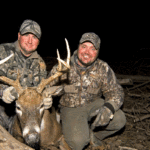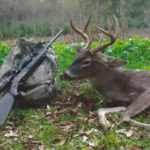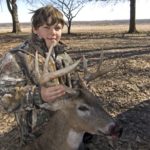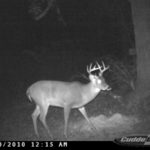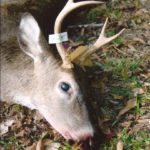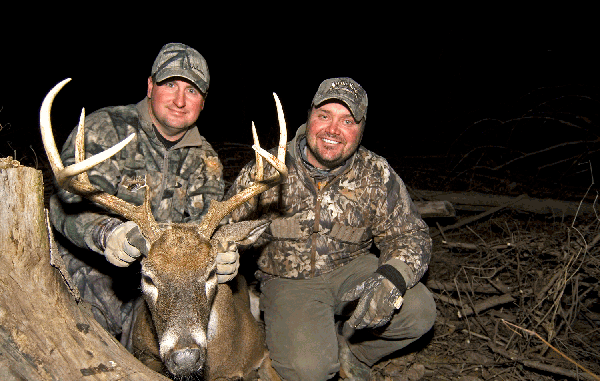
A balanced deer herd is an important part of any quality deer management program — and that means shooting more bucks.
We used to say at the deer camp not to shoot the does, now it’s don’t shoot the bucks. My how things have changed!
By now most everyone in the deer hunting community knows what the letters QDM stand for. Quality deer management is the type of deer management that has the objective of producing a quality deer herd with an older age class of bucks while providing hunters with quality deer hunting.
It is not trophy deer management, although it can produce trophy bucks.
In Louisiana, many clubs and private landowners have adopted QDM and are actively practicing the old motto of the Quality Deer Management Association: Let ’em Go and Let ’em Grow.
The QDMA is the national organization that promotes QDM, and the two should not be confused. One does not have to belong to the QDMA in order to practice QDM, although Louisiana is one the top states in the nation in terms of the number of association members.
Many years ago (in the ’60s) when deer herds were beginning to expand around the state thanks to the restocking efforts of LDWF, most of the hunting was bucks-only. Does were protected in order to allow herds to increase in numbers.
In the ’70s, when most deer herds really began to explode, shooting does was still taboo despite the efforts to increase doe days.
In the ’80s, DMAP was initiated to facilitate the doe harvest, and it did work to increase the doe harvest on most lands. However, the age structure in the buck population did not change because of the heavy hunting pressure on bucks. Clubs and landowners needed to pass up some of the younger bucks and let them get older, but this was not happening.
In the ’90s, quality deer management became popular across the country and got the attention of Louisiana deer hunters. Today, QDM is the norm.
Landowners and clubs have restricted the buck harvest using limits and antler restrictions. LDWF initiated a tagging system with a three-buck limit, and this has benefited the lands that are hunted but not being managed.
Very good bucks are now being killed across the state, as evidenced by the number of bucks qualifying for state and national recognition — so QDM is working.
But, while the overall deer harvest has declined around the state, what I am seeing on many of the lands I am familiar with is a decline in the buck harvest.
Table 1 shows the 2011 deer harvest on lands around Baton Rouge, and it is evident that hunters are not taking advantage of the buck segment in the population, for whatever reason. And there are a variety of reasons for this.
Table 1
2011 Deer Harvest on Selective QDM Lands
# Acres Buck Harvest Doe Harvest
1,400 7 (20) 10 (30)
1,000 4 (5) 7 (10)
1,200 1 (10) 16 (20)
5,000 37 (80) 82 (120)
1,000 6 (10) 12 (20)
1,400 4 (12) 20 (26)
()=recommended harvest
Now, keep in mind that the objectives of QDM are to keep the deer herd in balance with the habitat and increase the buck age structure by allowing bucks to get older. The harvest emphasis would seem to focus on the does with a reduction in the buck harvest.
Initially, the buck harvest would be less than the doe harvest, but at some point — after a couple of years — the buck harvest should begin to increase as the program begins to produce results.
Deer are born pretty much at a 50/50 ratio, so the harvest should be somewhat similar in order to keep the herd in balance, but it appears from the table that this is not being done.
One reason for this is the idea that every young buck needs to be passed up because it has the potential to become a trophy deer. While this sounds, good it is simply not true; all bucks are not created equal, and so much depends on the habitat and the available nutrition.
Good harvest records are an absolute must, and will clearly show what the growth and development potential is of a particular tract of land.
So, while passing up every buck that doesn’t meet the harvest criteria may sound good, it actually could be hurting the program. In every buck age class there are bucks that are above average, average and below average. The harvest emphasis should be to allow those younger bucks that are average or above average to grow older — and those that are below average should be harvested.
There is another reason bucks are being passed: Hunters simply cannot identify those animals that are below average, so they pass them up thinking they are going to grow older and better, when in fact they are not.
If the membership understands the growth and development trends, then the hunters should be able to identify those below-average bucks in each age class and harvest them.
QDMA has some excellent information about buck identification, commonly known as field judging deer. These hunters do not want to make a mistake or pay a fine for shooting the wrong deer (BTW, in my opinion there is never a wrong deer).
Still another reason for the lack of buck harvest is that many of the Baby Boomer hunters who have been the mainstay of the hunting community have voluntarily reduced their harvest. These hunters were around in the early days of DMAP, and shooting a lot of deer simply does not interest them anymore, unless it is a really big one.
And, finally, it seems to have become popular among hunters to brag about how many bucks one sees but did not shoot. The reality is that these hunters probably cannot field judge deer either, so they pass up bucks under the idea that it is a young deer that is going to get better.
The common method of QDM for increasing the buck age in a population is to not shoot 6-month-old males and 1 ½-year-old males. Some lands go further, protecting these two age classes and adding in the 2 ½-year-old age class. And on other lands these age classes and the 3 ½-year-old age class is protected. And then there are those clubs that only shoot B&C-class bucks.
These buck programs are all legitimate ways to increase the buck age and grow larger bucks, as long as the habitat is able to produce the quality bucks the hunters desire. If your habitat can do this, then you can have success. If it cannot, which includes a lot of the habitat in Louisiana, then you are wasting your time with a buck program until you can improve the habitat quality.
Dominant piney woods habitat is generally not able to produce bucks beyond the 120-inch B&C class. The necessary nutrition is simply not there. The poor soils of the historic longleaf pine regions of Louisiana do not produce many deer above the 120 class, and the marsh regions that have fair to good deer populations do not produce many deer of that quality either.
Just look at the Louisiana Big Game Records and see where the big ones come from: The bottomland forested regions with crop agriculture and the areas with a good hardwood component in the forests are at the top of the list of parishes with record-book deer.
So the first step in producing quality deer is to develop quality deer habitat. Once this is done, monitoring the deer harvest through data collection so growth and development trends can be established is a must.
If you do not keep records you are wasting your time with a buck-management program. You have to understand the growth and development trends of your land, and this will dictate your potential for success.
Hunters need to adjust their mind set that every deer is going to become a quality deer. If the habitat is poor or lacking in nutrition, deer quality (body growth and development) will be poor also. The buck segment might have a few older bucks that are OK, but there will be many low-end bucks.
Young low-end bucks become older low-end bucks. There is no reason at all not to harvest the low-end bucks; they are not going to become the big bucks hunters desire.
If you have been keeping good data, such bucks can be identified and targeted, and this will increase the harvest and also balance the harvest.
As bucks become older, they undergo a lot of stress during the rut, and natural mortality takes place. When this happens, you are losing not only deer but the time and money spent on your program.
Natural mortality is going to occur, but the impact can be reduced by targeting some of these low-end bucks. The article “Dominance Dilemma,” in the July issue of Louisiana Sportsman, was right on target about the impact the rut has on adult bucks. Learning to recognize these low-end adult bucks and targeting them could benefit the herd by reducing the number of competing males, which helps reduce the stress factor during the rut and increases your buck harvest.
A recent study on some QDM land in Maryland includes some eye-opening results. Of the 33 adult bucks that had radio collars on them, five were harvested by hunters, seven died from natural mortality, five from unknown causes and nine suffered cranial abscesses that occurred from fighting other bucks during the rut; some of these bucks with skull injuries died while, others lived another year — but their antler development was much reduced.
So the take-home lesson is that if you see a good buck and consider harvesting it, perhaps you should because there is risk in trying to move it up into an older age class. Saving or banking deer for future seasons can be a risk.
On our small property in Clinton, we had a good 9-point buck in 2010 that was still alive in 2011. I have yet to photograph this deer in 2012. I know it was alive at the end of last season, but it seems to have disappeared. I can’t help but believe that if it was still alive it would be hanging around the abundance of cowpeas and jointvetch that was grown this spring and summer on the property.
If our older bucks are dying of natural mortality, why don’t we just go back to the days of traditional deer management? We know that this type of management did not produce many older bucks because 75 percent of the harvest was 1 ½-year-old deer.
Quality deer management will produce results if you manage both the habitat and the herd. The key is to do both.
Keeping good harvest records in order to understand the growth and development trends of your herd will allow you to develop a program based upon the potential of your land.
Get involved with DMAP, and work with a biologist. Once you understand the capability of your habitat for producing quality bucks, you can make the necessary habitat improvement and make sound management decisions regarding what deer to harvest.
Shoot your does, but also shoot the bucks. Know what a low-end buck looks like and target it, both the young ones and the adults.
The younger bucks that have the most potential should be allowed to grow older
By increasing the buck harvest and achieving an overall balanced deer harvest, hopefully there will be a subsequent reduction in natural mortality — and the better bucks will be around for the next season.
And when you get the chance to harvest a good buck, you might want to do so. They do get smarter as they grow older, and this, too, can impact your success.
